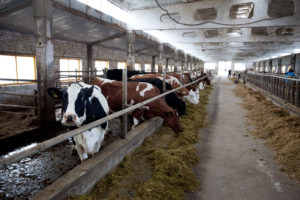Changes in the agricultural sector by 2050: a look into the future

The agro-industrial complex (AIC) is on the verge of significant changes that will be dictated by many factors, including social, technological and environmental. Forecasts from the Food and Agriculture Organization of the United Nations (FAO) and the Center for Scientific and Technological Forecasting at the Higher School of Economics show that by 2050 we will face new challenges and opportunities. Let's consider the key areas that will determine the future of the agro-industrial complex.
1. Population growth and urbanization
The global population is projected to exceed 9 billion by 2050. This will create a huge demand for food , while urbanization will reduce available agricultural land and labor. In response to these challenges, it is necessary to introduce highly efficient technologies.
The Internet of Things (IoT) and drones are already beginning to find applications in agriculture, allowing for optimization of planting, plant care and harvesting processes . Vertical farming will become an important solution for urban agricultural systems, allowing food to be grown in limited space. Using renewable energy will also help reduce dependence on fossil resources and make agriculture more sustainable.
2. Alternative Protein Sources With increasing HEALTH
and environmental awareness , the alternative protein market will gain popularity. By 2050, consumption is expected to shift from traditional protein sources such as MEAT and dairy to more sustainable and environmentally friendly alternatives including cultured meat and algae . Institutional changes, such as support for research and development in alternative proteins, will allow greater use of both animal and plant proteins. This will not only reduce the burden on the environment, but will also offer consumers healthier food options. 3. Environmental trends and sustainable development Environmental factors will have a significant impact on the agricultural sector. It is expected that reductions in greenhouse gas emissions in agriculture will be achieved not by expanding agricultural land, but by increasing productivity. This will require introducing new agronomic practices such as crop rotation, organic farming and reducing the use of chemical fertilizers. In addition, waste recycling technologies will play an important role in creating closed cycles in the agricultural sector. Using organic waste to produce biogas or compost will not only reduce waste, but also improve soil quality. 4. Innovation and digitalization
Digitalization of the agro-industrial complex will be a key factor in increasing its efficiency. Using big data and analytics will allow farmers to optimize processes, predict yields and manage resources more efficiently.
It is also worth noting that blockchain can be used to increase the transparency of supply chains, which is especially important in the context of globalization and growing requirements for product quality.
By 2050, the agricultural sector expects many changes caused by both internal and external factors. The introduction of new technologies, the transition to sustainable protein sources and environmentally friendly practices, as well as the digitalization of processes will all create new opportunities for the development of the agricultural sector. It is important that all stakeholders, including government , business and academia, work together to ensure a sustainable future for the food system.
Read together with it:
- UniCredit заявил о галактических усилиях из-за санкций против РоссииUniCredit старается не нарушить «более 15 тыс. санкций», а также не «совершать ошибки», которые позволят изъять его активы в России, заявил гендиректор. После начала военной операции банк начал рассматривать возможность ухода Итальянский банк UniCredit прилагает «галактические усилия», пытаясь соблюсти международные санкции в отношении своего российского подразделения. Об этом заявил генеральный д...
- He crawled to the icon with prayer. The true story of a man who overcame drug addiction.Alexander Ovchinnikov. Topic News. Our project's hero was a drug addict for many years. The thought that this was a dead end never left him, but his addiction proved stronger. One day, when he could no longer walk, he crawled to an icon in prayer. This became his first step toward a new life. Today, he heads a charity center that helps those who have given up hope and are unable to quit ALCOHOL an...
- Низкое предложение и устойчивый спрос: в Аргентине растут цены на мясоЦены на говядину снова выросли, что отразилось на полках супермаркетов и в мясных магазинах. За последние две недели розничные цены выросли на 8–12%, а на некоторые популярные отрубы рост превысил 15% по сравнению с октябрем. Тем не менее, продажи остаются высокими: потребители продолжают покупать, принимая новые цены и закрепляя тенденцию, которая повторяется каждый год в конце года, когда спрос ...
- Смоленская область — лидер России по производству крольчатиныВ интервью «Агроэксперту» заместитель председателя регионального правительства Алексей Кучумов отметил, что регион достиг самодостаточности по таким продуктам, как яйца, мясо и картофель, превышая уровень 100%. Кроме того, Смоленская область занимает первое место по посевным площадям льна, а также активно развивает молочное животноводство, с общим поголовьем более 1......
- Зеленский ввел санкции против своего бизнес-партнераМиндич и Александр Цукерман, который, как считается, отвечает за его финансовые вопросы, значатся как граждане Израиля. Санкции против них ввели на три года, они включают блокировку активов. На Украине сочли ограничения мягкими Владимир Зеленский Президент Украины Владимир Зеленский подписал указ о введении санкций в отношении совладельца студии «Квартал 95» Тимура Миндича и его знакомого бизнесме...
- Лучшие не только по молоку. Какие рекорды поставили в экспериментальной базе имени КотовскогоНовости темы Экспериментальная база имени Котовского известна далеко за пределами Узденщины благодаря высоким показателям, которых из года в год добиваются в хозяйстве. Лучшие результаты в районе агропредприятие показывает как по молоку и зерновым, так и по сахарной свекле. Страда этого года, проходившая не в самых простых погодных условиях, также стала рекордной. Хлеб – всему голова Весна 2.........


